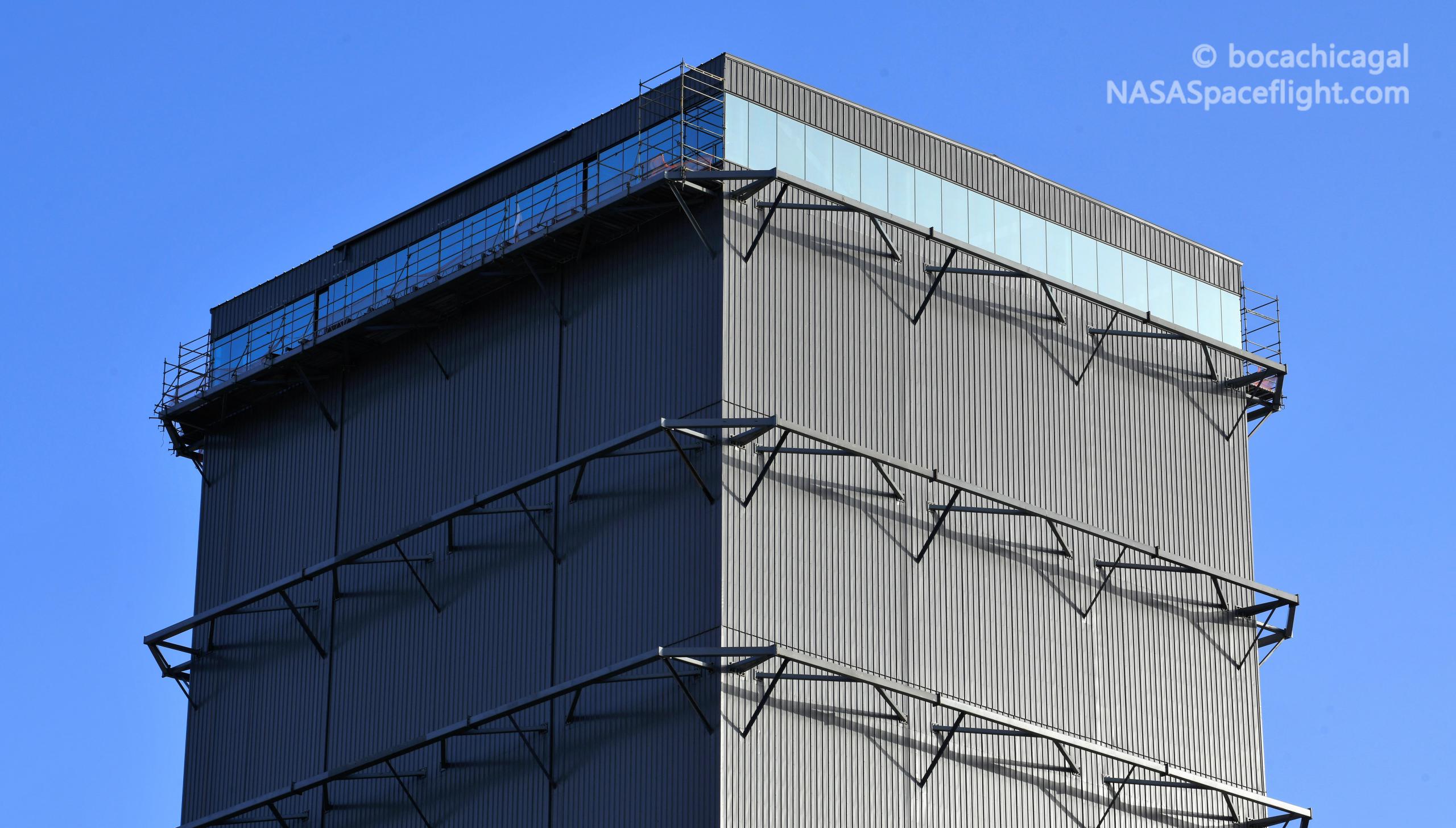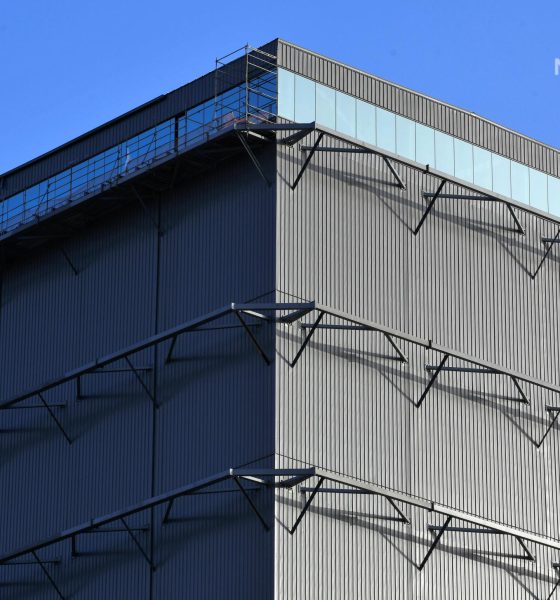

News
SpaceX Starship factory breaks ground on an even bigger ‘high bay’
SpaceX appears to have more or less broken ground on a new, even bigger ‘high bay’ assembly facility at its Boca Chica, Texas Starship factory.
Barely one year ago, SpaceX erected the first prefabricated steel sections of what eventually become its Starship factory ‘high bay’ – a spartan 81m (~265 ft) tall designed at the most basic level to shield final Starship and Super Heavy booster assembly from the elements. Situated near the southernmost tip of Texas and just a few miles west of the Gulf of Mexico, those “elements” can be less than pleasant at SpaceX’s primary Starship factory, ranging from sauna-like heat and humidity and mosquitoes the size of quarters to regular downpours, thunderstorms, tropical conditions, and even hurricanes.
While a great deal of work at Starbase is still done out in the open with little more than an umbrella as protection, SpaceX has nevertheless worked to find a middle ground where the most sensitive work (mainly structural welding) can be mostly shielded from wind and rain. First, SpaceX built a (relatively) tiny ‘windbreak’ too small for much of anything. Two years later, the windbreak is partially used for Starship nose section assembly – when a nose cone is stacked on and welded to a separate stack of four steel rings.
A few months after the triangular windbreak was fully finished, SpaceX started work on a larger box-like building that would eventually be known as the Starship factory’s ‘midbay.’ Standing around 45m (~150 ft) tall, the midbay was designed to support the process of assembling Starship tank sections from several stacks of 2-4 steel rings but was – for whatever reason – left too short to support the full Starship assembly process.
Instead, once Starship tank sections were finished, they would have to be rolled out of the midbay for nose installation. Eventually, in July 2020, SpaceX began assembling an even larger ‘high bay’ that would ultimately measure 81m (~265 ft) tall and 20-25m (65-80 ft) wide and deep – easily big enough to fit the company’s existing Falcon 9 or Falcon Heavy rockets with room to spare. More importantly, of course, the high bay was built to be large enough to support Super Heavy assembly from start to finish, giving SpaceX teams a sheltered place to build the largest rocket boosters in history.
As of August 2021, SpaceX’s midbay has supported the assembly of 10 Starship prototypes, 5-6 propellant storage tanks, and several ‘test tanks,’ while the newer high bay has helped SpaceX build three (mostly) complete Super Heavy boosters in 2021. However, working at full speed, SpaceX’s midbay is really only capable of supporting the assembly of one Starship tank section (and more general work on two) at a time and the high bay – while offering at least twice the covered surface area – appears to be limited to simultaneous work on two or three different stacks (boosters, ships, tanks, etc.).
As SpaceX slowly but surely treks towards the end of approximately two years almost exclusively dedicated to building ever-changing prototypes, it’s been clear for a while that the company would need to drastically expand its production facilities to produce the dozens of Starships and boosters CEO Elon Musk has been publicly dreaming of. Even at lower volumes, those existing facilities – while great for producing a dozen or more prototypes per year – would still become a chokepoint for the near-term production of a small fleet of operational Starships and Super Heavies.
Construction starts soon on a much larger high bay just north of current high bay— Elon Musk (@elonmusk) July 25, 2021
In turn, Musk revealed that SpaceX was about to start building “a much larger high bay” adjacent to the existing structure in late July. On August 20th, a little over a year after assembly of the original high bay kicked off, SpaceX began the process of tearing up existing concrete for the even larger bay – breaking ground, at least in a sense. According to Musk, the newest addition to Starbase’s Starship factory will be about 10% taller (~90m vs 81m), substantially wider, and likely a bit deeper than the existing high bay, allowing for the installation of two side-by-side bridge cranes with tracks running the full width of the building.
With at least 2-3 times more surface area than the high bay, the new wide bay should give SpaceX enough space to simultaneously assemble something like 4-8 Starships or Super Heavy boosters. Depending on which direction SpaceX goes, the wide bay could also potentially be large enough for SpaceX to create the first true Starship and Super Heavy assembly lines, though that would be a substantial departure from Starbase’s existing approach to manufacturing.

News
Tesla FSD fleet is nearing 7 billion total miles, including 2.5 billion city miles
As can be seen on Tesla’s official FSD webpage, vehicles equipped with the system have now navigated over 6.99 billion miles.

Tesla’s Full Self-Driving (Supervised) fleet is closing in on almost 7 billion total miles driven, as per data posted by the company on its official FSD webpage.
These figures hint at the massive scale of data fueling Tesla’s rapid FSD improvements, which have been quite notable as of late.
FSD mileage milestones
As can be seen on Tesla’s official FSD webpage, vehicles equipped with the system have now navigated over 6.99 billion miles. Tesla owner and avid FSD tester Whole Mars Catalog also shared a screenshot indicating that from the nearly 7 billion miles traveled by the FSD fleet, more than 2.5 billion miles were driven inside cities.
City miles are particularly valuable for complex urban scenarios like unprotected turns, pedestrian interactions, and traffic lights. This is also the difference-maker for FSD, as only complex solutions, such as Waymo’s self-driving taxis, operate similarly on inner-city streets. And even then, incidents such as the San Francisco blackouts have proven challenging for sensor-rich vehicles like Waymos.
Tesla’s data edge
Tesla has a number of advantages in the autonomous vehicle sector, one of which is the size of its fleet and the number of vehicles training FSD on real-world roads. Tesla’s nearly 7 billion FSD miles then allow the company to roll out updates that make its vehicles behave like they are being driven by experienced drivers, even if they are operating on their own.
So notable are Tesla’s improvements to FSD that NVIDIA Director of Robotics Jim Fan, after experiencing FSD v14, noted that the system is the first AI that passes what he described as a “Physical Turing Test.”
“Despite knowing exactly how robot learning works, I still find it magical watching the steering wheel turn by itself. First it feels surreal, next it becomes routine. Then, like the smartphone, taking it away actively hurts. This is how humanity gets rewired and glued to god-like technologies,” Fan wrote in a post on X.
News
Tesla starts showing how FSD will change lives in Europe
Local officials tested the system on narrow country roads and were impressed by FSD’s smooth, human-like driving, with some calling the service a game-changer for everyday life in areas that are far from urban centers.

Tesla has launched Europe’s first public shuttle service using Full Self-Driving (Supervised) in the rural Eifelkreis Bitburg-Prüm region of Germany, demonstrating how the technology can restore independence and mobility for people who struggle with limited transport options.
Local officials tested the system on narrow country roads and were impressed by FSD’s smooth, human-like driving, with some calling the service a game-changer for everyday life in areas that are far from urban centers.
Officials see real impact on rural residents
Arzfeld Mayor Johannes Kuhl and District Administrator Andreas Kruppert personally tested the Tesla shuttle service. This allowed them to see just how well FSD navigated winding lanes and rural roads confidently. Kruppert said, “Autonomous driving sounds like science fiction to many, but we simply see here that it works totally well in rural regions too.” Kuhl, for his part, also noted that FSD “feels like a very experienced driver.”
The pilot complements the area’s “Citizen Bus” program, which provides on-demand rides for elderly residents who can no longer drive themselves. Tesla Europe shared a video of a demonstration of the service, highlighting how FSD gives people their freedom back, even in places where public transport is not as prevalent.
What the Ministry for Economic Affairs and Transport says
Rhineland-Palatinate’s Minister Daniela Schmitt supported the project, praising the collaboration that made this “first of its kind in Europe” possible. As per the ministry, the rural rollout for the service shows FSD’s potential beyond major cities, and it delivers tangible benefits like grocery runs, doctor visits, and social connections for isolated residents.
“Reliable and flexible mobility is especially vital in rural areas. With the launch of a shuttle service using self-driving vehicles (FSD supervised) by Tesla in the Eifelkreis Bitburg-Prüm, an innovative pilot project is now getting underway that complements local community bus services. It is the first project of its kind in Europe.
“The result is a real gain for rural mobility: greater accessibility, more flexibility and tangible benefits for everyday life. A strong signal for innovation, cooperation and future-oriented mobility beyond urban centers,” the ministry wrote in a LinkedIn post.
News
Tesla China quietly posts Robotaxi-related job listing
Tesla China is currently seeking a Low Voltage Electrical Engineer to work on circuit board design for the company’s autonomous vehicles.

Tesla has posted a new job listing in Shanghai explicitly tied to its Robotaxi program, fueling speculation that the company is preparing to launch its dedicated autonomous ride-hailing service in China.
As noted in the listing, Tesla China is currently seeking a Low Voltage Electrical Engineer to work on circuit board design for the company’s autonomous vehicles.
Robotaxi-specific role
The listing, which was shared on social media platform X by industry watcher @tslaming, suggested that Tesla China is looking to fill the role urgently. The job listing itself specifically mentions that the person hired for the role will be working on the Low Voltage Hardware team, which would design the circuit boards that would serve as the nervous system of the Robotaxi.
Key tasks for the role, as indicated in the job listing, include collaboration with PCB layout, firmware, mechanical, program management, and validation teams, among other responsibilities. The role is based in Shanghai.
China Robotaxi launch
China represents a massive potential market for robotaxis, with its dense urban centers and supportive policies in select cities. Tesla has limited permission to roll out FSD in the country, though despite this, its vehicles have been hailed as among the best in the market when it comes to autonomous features. So far, at least, it appears that China supports Tesla’s FSD and Robotaxi rollout.
This was hinted at in November, when Tesla brought the Cybercab to the 8th China International Import Expo (CIIE) in Shanghai, marking the first time that the autonomous two-seater was brought to the Asia-Pacific region. The vehicle, despite not having a release date in China, received a significant amount of interest among the event’s attendees.








